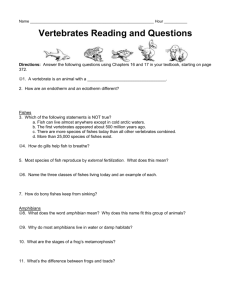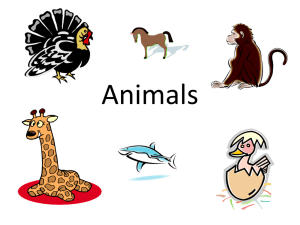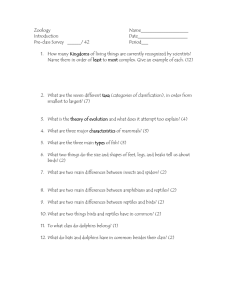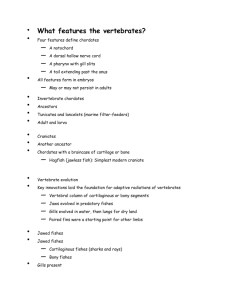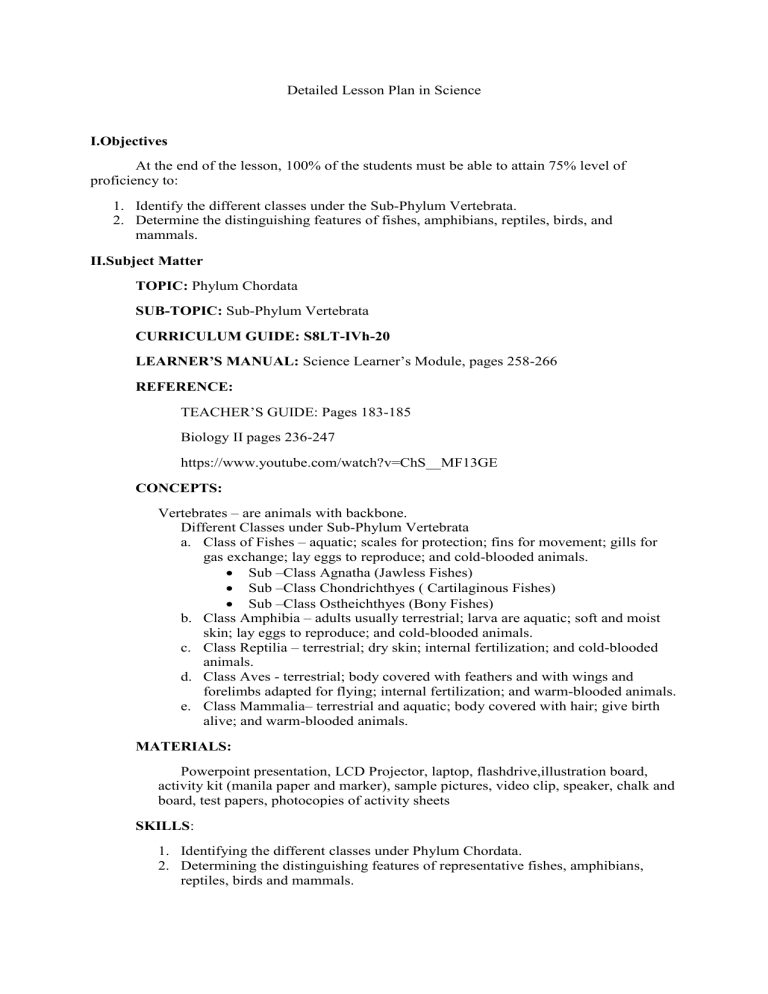
Detailed Lesson Plan in Science I.Objectives At the end of the lesson, 100% of the students must be able to attain 75% level of proficiency to: 1. Identify the different classes under the Sub-Phylum Vertebrata. 2. Determine the distinguishing features of fishes, amphibians, reptiles, birds, and mammals. II.Subject Matter TOPIC: Phylum Chordata SUB-TOPIC: Sub-Phylum Vertebrata CURRICULUM GUIDE: S8LT-IVh-20 LEARNER’S MANUAL: Science Learner’s Module, pages 258-266 REFERENCE: TEACHER’S GUIDE: Pages 183-185 Biology II pages 236-247 https://www.youtube.com/watch?v=ChS__MF13GE CONCEPTS: Vertebrates – are animals with backbone. Different Classes under Sub-Phylum Vertebrata a. Class of Fishes – aquatic; scales for protection; fins for movement; gills for gas exchange; lay eggs to reproduce; and cold-blooded animals. Sub –Class Agnatha (Jawless Fishes) Sub –Class Chondrichthyes ( Cartilaginous Fishes) Sub –Class Ostheichthyes (Bony Fishes) b. Class Amphibia – adults usually terrestrial; larva are aquatic; soft and moist skin; lay eggs to reproduce; and cold-blooded animals. c. Class Reptilia – terrestrial; dry skin; internal fertilization; and cold-blooded animals. d. Class Aves - terrestrial; body covered with feathers and with wings and forelimbs adapted for flying; internal fertilization; and warm-blooded animals. e. Class Mammalia– terrestrial and aquatic; body covered with hair; give birth alive; and warm-blooded animals. MATERIALS: Powerpoint presentation, LCD Projector, laptop, flashdrive,illustration board, activity kit (manila paper and marker), sample pictures, video clip, speaker, chalk and board, test papers, photocopies of activity sheets SKILLS: 1. Identifying the different classes under Phylum Chordata. 2. Determining the distinguishing features of representative fishes, amphibians, reptiles, birds and mammals. VALUES: Show appreciation on the importance of vertebrate animals in the environment. III. Procedures Teacher’s Activity Student’s Activity A. Routinary Activities Prayer: Please stand up and let us pray. Lead the prayer _____. (The students will pray.) Greetings: Good morning class. Good morning Ma’am. Good morning classmates. Mabuhay! Checking of Attendance: Is there any absent for today? (The attendance officer will report to the class.) Checking of Assignments: Class, I asked you to bring the materials for today’s activity and make some research about vertebrates. Did you do your assignment? Good, we will be using those materials later in the activity. Keep all your materials under your work table first. Yes, Ma’am. (Materials will be placed under their work table.) Review of the Previous Lesson: Last time, we had discussed about invertebrates, again what are those ? Invertebrate animals are animals without backbone. Correct. Now, give some examples of invertebrate animals. Is there any question regarding our previous lesson? Good. Since you really understand our lesson, give yourselves a “Aling Dionisia Clap”. (Answers may vary.) None, Ma’am. (Students will do a “Aling Dionisia Clap”.) B. Motivation: Class, we are going to have a guessing game, named “Name That Tune”, but before we proceed, group leaders will you please come here in front and get your materials that you will use for the game. (The leaders of each group will get their materials.) Now listen carefully to the mechanics of the game. The tune of the song will be played within 10-15 seconds. While the music is playing,you have the chance to write the answer on the illustration board. The first group who will raise their answer correctly get the point. If you fail to guess it, the other groups will have the chance to win the point. We only have six songs. The group with the highest points will be our winner. Understood? Yes, Ma’am. Are you ready? Yes, we are ready. Let us start. (Students will play Name That Song.) Title of the song to guess: Three Little Ducks Eye of the Tiger Baa Baa Black Sheep Rudolph The Red-Nosed Reindeer Five Little Monkeys Mary Had A Little Lamb INTRODUCTORY PERIOD: (The title of the songs are posted on the board.) By simply observing the titles of the song on the board, what do they have in common? All of the given titles have the name of an animal on it. Nice observation. We have duck , tiger, sheep, reindeer, monkeys and lamb in the list. What do these animals possess that invertebrates don’t have? Ma’am those animals have backbones. That’s right! And that backbone has connection in our today’s lesson. How do you call those animals with backbones? Animals with backbone are called vertebrates. Very good. And that will be our itenerary for today. We are going to explore the world of vertebrates. Class,are you excited? Yes, Ma’am.We’re Excited. Again what are vertebrates? That’s right. How about the Classes of organisms under sub-phylum vertebrata. Are you familiar with them? Vertebrates are called animals with backbones.They have an internal framework known as an endoskeleton. Yes, Ma’am. Good. Then name those 5 classes of organisms. Alright. For you to furtherly know about these vertebrates, we will have a short activity. Are you ready? The 5 classes of organisms under subphylum vertebrata are: Class of Fishes,Class Amphibia,Class Reptilia,Class Aves and Class Mammalia. Yes Ma’am, we are ready? Leaders, please get your activity sheet . (Leaders will get their activity sheets) A. Pre –Activity Class, what is the title of the activity? The title of the activity is “Comparing Vertebrate Animals.” What is the objective that we need to meet for today? To determine the features of representative fish, amphibians, reptiles, birds and mammals. Be reminded that this is a group activity, you must cooperate with your leader, share ideas quietly; maintain cleanliness and orderliness of the room while performing the activity. B. Activity Proper Class, each group will receive an activity kit, containing manila paper, and marker which you will use to answer the guide questions given. Here are the following questions that you need to answer. (Questions will be projected on white screen.) Q1. Describe the body covering. Q2. In terms of reproduction, how do they differ? Q3. Which animals are ectothermic? Which are endothermic? Q4. Which are aquatic animals? Which are terrestrial animals? You are given only 10 minutes to perform the activity. (Students will do the activity.) (The teacher will supervise the students while performing the activity.) C. Post- Activity Okay, our time is up. Class, may you post your work on the board and explain. Group 1 will be the first reporter, then 2 and lastly group 3. Is that clear? Yes, Ma’am. (The group leaders will report the result of the activity.) Guide Questions: Q1. Describe the body covering. Q2. In terms of reproduction, how do they differ? Q3. Which are ectothermic? Which are endothermic? A1: Fishes are covered with scales for protection; amphibians have soft and moist skin; reptiles are covered with dry skin; birds are covered with feathers and with wings and forelimbs for flying; and mammals are covered with hair. A2: Fishes and amphibians lay eggs to reproduce, reptiles and birds undergo internal fertilization and mammals give birth alive. A3: Birds and mammals are endothermic animals while fishes, reptiles, and amphibians are ectothermic animals. Q4. Which are aquatic animals? Which are terrestrial animals? A4: Fishes are aquatic, reptiles and birds are terrestrials, amphibians and mammals are both aquatic and terrestrial animals. (Sample pictures of animals in each class will be shown in support of the discussion.) APPLICATION Nice. Since you are now familiar with all the features of the different vertebrates. I prepared a surprise game for you.We are going to complete this table using the given cartolina strip. Vertebrate Body Covering Fishes Amphibians Reptiles Birds Mammals Reproduction Body Temperature Habitat Examples Let us start. (Students will fill up the blank table using flash cards.) Vertebrate Body Reproduction Body Temperature lay eggs to ectothermic Habitat Examples Covering Fishes scales aquatic reproduce lamprey sharks stingray Amphibians Reptiles soft and moist skin lay eggs to reproduce dry skin internal fertilization ectothermic ectothermic both aquatic and terrestrial frog terrestrial crocodiles toads Snakes Birds Mammals feathers with wings and forelimbs internal fertilization body covered with hair give birth alive endothermic terrestrial ostrich chicken endothermic both terrestrial and aquatic dogs cats bat GENERALIZATION: To wrap up our discussion, what can you say about the distinguishing features of vertebrates? In terms of their body coverings: Fishes are covered with scales; amphibians with soft and moist skin; reptiles with dry skin; birds with feathers and wings; and mammals are covered with hair. For their body temperature: Animals belong to Class Aves and Mammalia are warm-blooded and under Class Reptilia, Amphibia and Class of Fishes are coldblooded. When we are talking about their mode of reproduction: Fishes and amphibians lay eggs, reptiles and birds through internal fertilization and mammals give birth alive. Lastly for their habitat: Reptiles and birds live on land; fishes live on water; amphibians and mammals live both on land and on water. Very well said! VALUING: Now that you already know the different features of vertebrate animals, let’s talk about their role or importance to us humans. I have here a 3-minute video about the relationship of humans to other vertebrate animals. I want you analyze the message of the video and reflect on it afterwards. Is that clear? Yes, Ma’am. (The video clip will play.) What is the title of the video clip? The title of the video clip is “Man”. What do you think is the message of the video? The message of the video is that don’t treat animals as heartless creatures and avoid cruelty and inhumane activities. Very well said. As the highest form of vertebrates, what is our responsibility to other vertebrates? Very good! Always remember that animals have heart that feel, eyes that see and families to care for, just like you and me. Ensuring animal’s welfare is our responsibility that includes consideration for all aspects of animal well-being. IV. Evaluation: Multiple Choice: Choose and encircle the letter of the correct answer. 1. My body is covered with hair. I give birth alive. I live both on land and water. I am warm-blooded. Where do I belong? a. Class Reptilia b. Class Amphibia c. Class Mammalia d. Class Aves 2. I undergo internal fertilization. I can fly because I have my wings and forelimbs. My body covered with feathers. I am warm-blooded. I live on land. Where I belong? a. Class Mammalia b. Class Reptilia c. Class Amphibia d. Class Aves 3. If amphibians: soft and moist skin, how about fishes: _____? a. Scales b. Feathers c. Hair d. Dry skin 4. If reptiles: internal fertilization, how about birds: _____? a. Internal fertilization b. Lay eggs to reproduce c. Give birth alive d. External fertilization 5. If mammals: body covered with hair, how about reptiles: _____? a. Scales b. Feathers c. Soft and moist skin d. Dry skin V. Assignment: Identify the given animals whether a fish, reptile, amphibian, bird, and mammal. Write the answer on the space provided. 1. 2. 3. 4. 5. Alligator = ____________ Bear = ________________ Tuna = ________________ Salamander = ___________ Penguin = ______________ Prepared by: Bautista, Angie M. Bachelor of Secondary Education Biological Science
